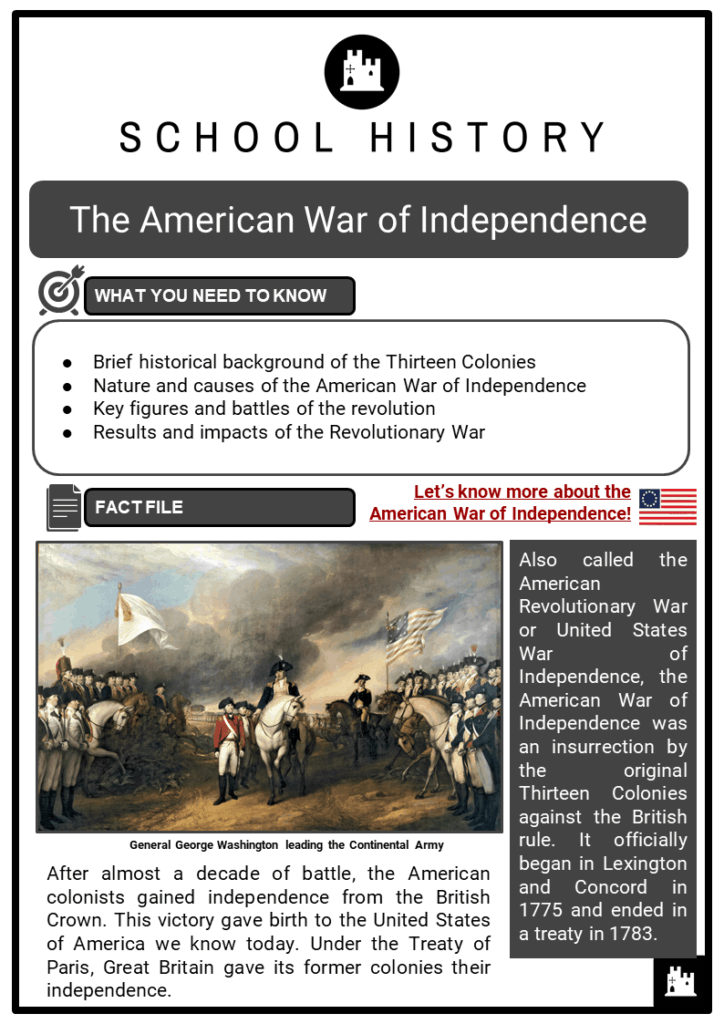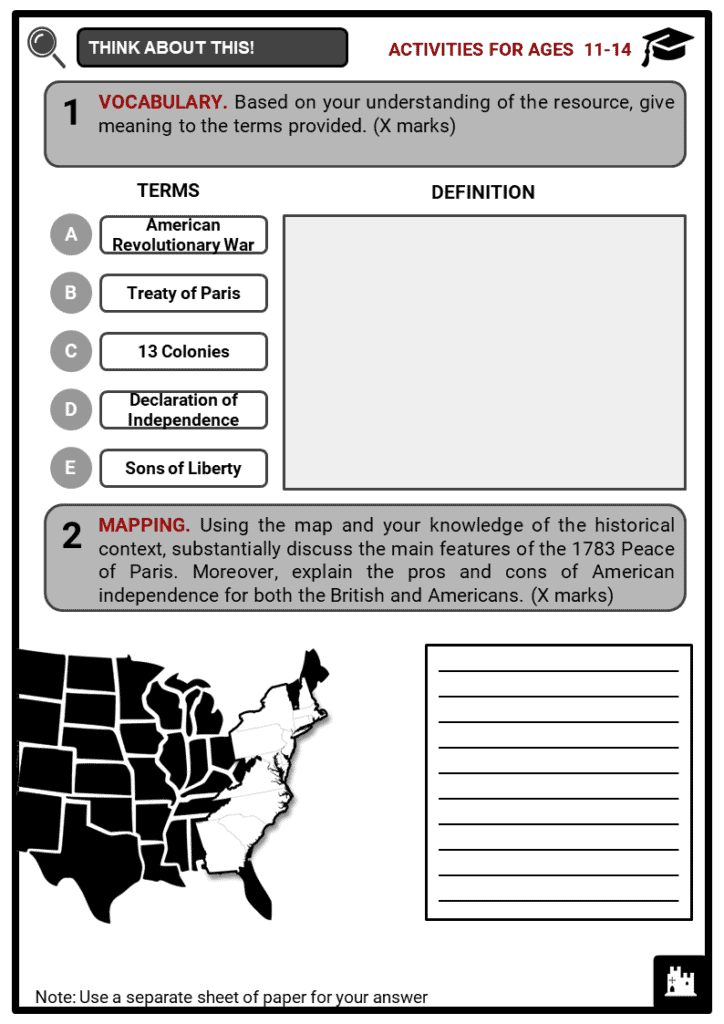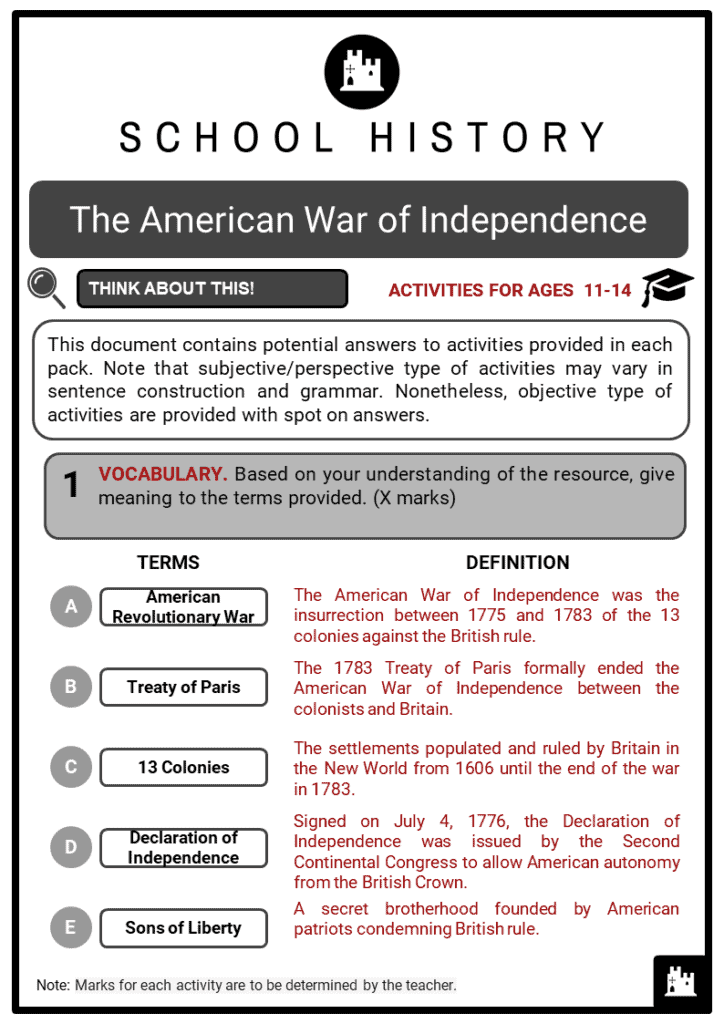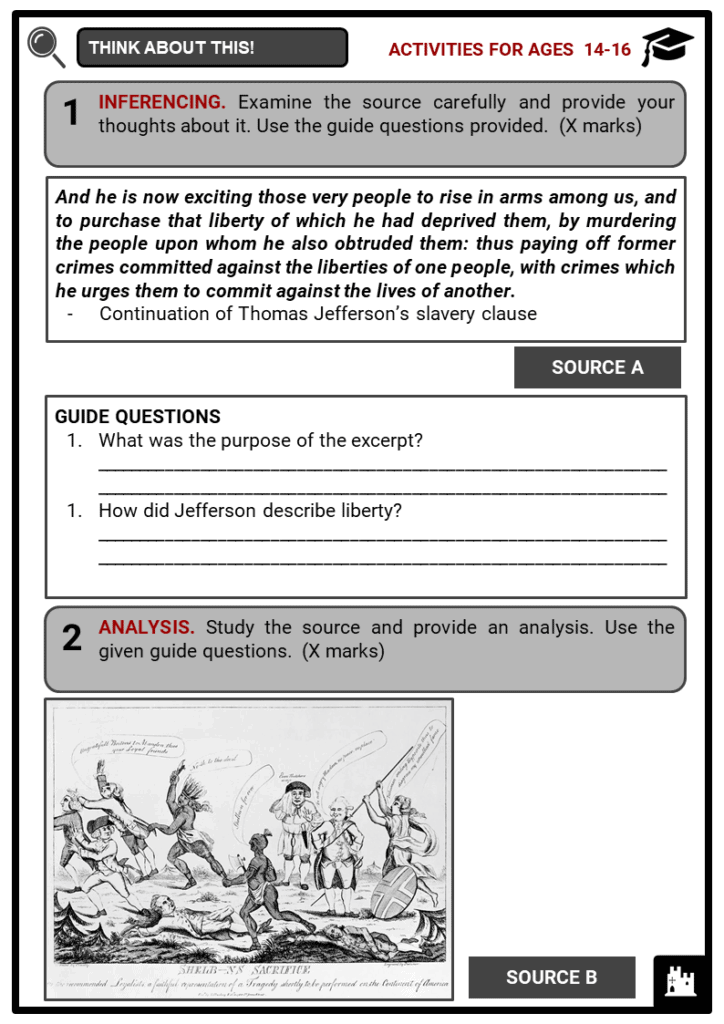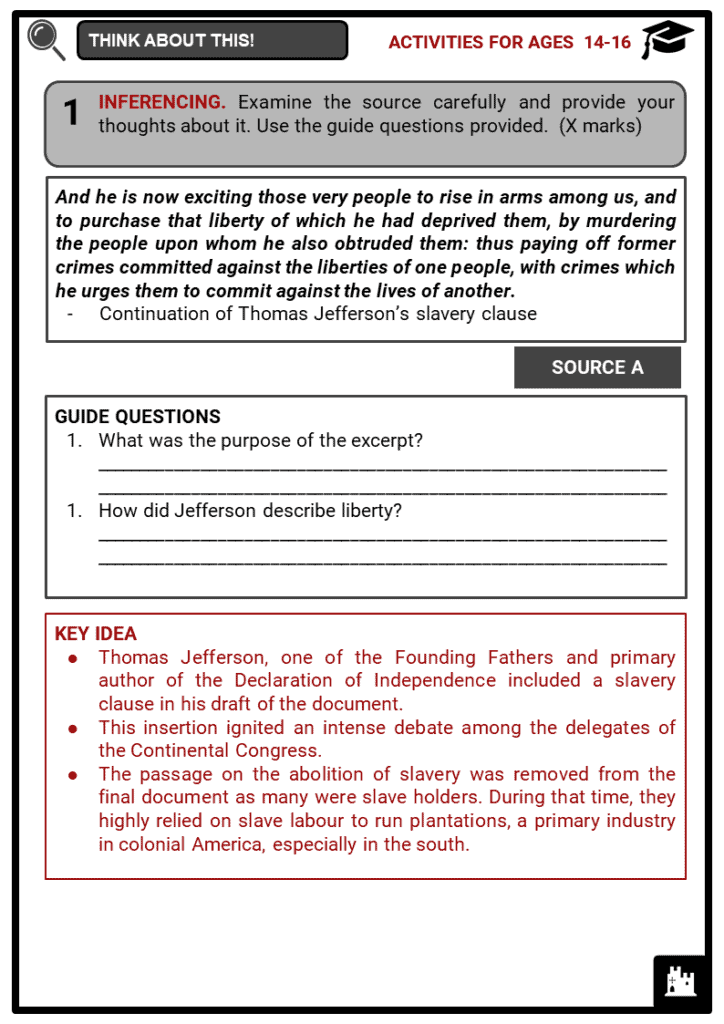Download The American War of Independence Worksheets
Do you want to save dozens of hours in time? Get your evenings and weekends back? Be able to teach The American War of Independence to your students?
Our worksheet bundle includes a fact file and printable worksheets and student activities. Perfect for both the classroom and homeschooling!
Table of Contents
Add a header to begin generating the table of contents
Summary
- Brief historical background of the Thirteen Colonies
- Nature and causes of the American War of Independence
- Key figures and battles of the revolution
- Results and impacts of the Revolutionary War
Key Facts And Information
Let’s know more about the American War of Independence!
- After almost a decade of battle, the American colonists gained independence from the British Crown. This victory gave birth to the United States of America we know today. Under the Treaty of Paris, Great Britain gave its former colonies their independence.
- Also called the American Revolutionary War or United States War of Independence, the American War of Independence was an insurrection by the original Thirteen Colonies against the British rule. It officially began in Lexington and Concord in 1775 and ended in a treaty in 1783.
Brief historical background of the Thirteen Colonies
- Demographically, the population in British American colonies reached 250,000 by the early 1700s. The increasing British population in the New World marked the establishment of stronger Anglo-American relations.
- In 1606, Jamestown (named after King James I), became the first official British settlement in America. Virginia then received the first batch of enslaved Africans in 1619.
- By 1632, as granted by the British Crown, Maryland, named after the Queen, was established as a colony.
- In 1620, a small group of Pilgrims arrived and settled in the Plymouth Colony. After a decade, the Massachusetts colony was founded by the Puritans.
- By 1665, Puritans extended to Connecticut, followed by the colony of Rhode Island, and New Hampshire which formed the New England colonies.
- In 1664, King Charles II granted his brother James, the Duke of York, lands between New England and Virginia which later became known as New York. Most settlers were Dutch, French, Scandinavian or German.
- In 1680, Quaker William Penn received miles of land west of the Delaware River from the King. Initially, the land became known as the colony of ‘Penn’s Woods’, later Pennsylvania, completing the Middle Colonies.
- In 1729, the colony of Carolina, covering the south from Virginia to Florida, was split into North and South. Given the close ties with British planters in the Caribbean, Carolina developed as a colony highly dependent on slave labour. Inspired by the buffer between the Spanish settlement of Florida and the Carolinas, in 1732 Georgia was founded by James Oglethorpe and joined the Southern Colonies.
- By 1700, the original Thirteen Colonies were inhabited by about 2,400,000 European and African settlers in addition to the Native American population. The British Crown aimed to expand the empire to counter the Spanish growing power. Trading ports were built along the coast of the Americas to enlarge commerce, trade, and employment.
- Many colonies including Pennsylvania, Massachusetts, Maryland, Rhode Island, and Connecticut were founded by charismatic religious leaders seeking freedom, while others were economic opportunities.
How did the British crown rule the original Thirteen Colonies?
- Under the British rule, the territories in America were then called colonies, provinces, or dominions.
- For each colony, the King appointed royal governors to rule and impose British common law under his name. With limited self-government, local and provincial governments were voted by wealthy landowners (patroons) subject to the approval of the colony’s governor.
- In most parts of the Thirteen Colonies, slavery was legal and widely practised. Most slaves worked in plantations and households. In the mid 1700s, the colonies developed independent governments and money systems from each other. With a growing population and increased trade opportunities, the colonists felt restricted by the British mercantile policies.
Nature and causes of the American Revolutionary War
- The American Revolution was a political battle that took place between 1765 and 1783 during which colonists in the Thirteen American Colonies rejected the British monarchy and aristocracy, overthrew the authority of Great Britain, and founded the United States of America.
The French and Indian War
- Britain originally used both diplomacy and war to establish colonies, but over time the cost of these wars, mainly the French and Indians Wars that ended in 1763, became prohibitively expensive.
- Both the French and the British allied with several Native American Indian tribes.
- Britain perceived that its financial recovery would be with the assistance of the colonies, who would pay the rising national debt incurred because of the wars in the colonies.
- To raise money, Britain developed and passed a flurry of laws such as the Navigation Acts, the Stamp Act and the Revenue Act that imposed taxes on colonies, commodities of trade and outlined rules of engagement that favoured them at the exclusion of all others including the colonists in America.
Colonial Taxes and Laws
- In 1764, tax was levied on sugar and molasses imported into the colonies through the Sugar Act passed by the British Parliament. The act amended the existing Molasses Act of 1733 that increased duties on imported molasses.
- In 1765, the Stamp Act placed tax on printed materials, including pamphlets, newspapers, and legal documents. Due to resounding opposition from the colonists, the act was repealed the next year.
- In order to improve living conditions of British troops and cut the cost to the crown, the Quartering Act was passed in 1765 that required colonial assemblies to provide housing and basic care for the troops.
- Another revenue driven act was passed in 1767, the Townshend Acts that levied duties on 72 items, such as paint, tea, paper, and glass. Moreover, it established the American Customs Boards that ignited colonists’ resistance and resulted in the bloody incident in Boston.
- In 1773, the Tea Act granted the East India Company sole right to import and distribute tea in the 13 colonies. As a result, smugglers increased and by December, a number of Bostonians dumped hundreds of chests of tea into the harbour, which later became known as the Boston Tea Party.
- As punishment to the colonists, especially in Boston, the British Parliament passed the Intolerable Acts in 1774. Also known as the Coercive Acts, they consisted of five laws: the Boston Port Act, Massachusetts Government Act, Administration of Justice Act, Quartering Act, and Quebec Act.
Incidents in Boston
- On March 5, 1770, a mob harassment by the colonists near the Customs House in Boston resulted in open fire by a couple of British soldiers. As a result, nine crowd members were shot, and three died. For the Americans, this event became known as the Boston Massacre.
- In protest to tax on tea and the monopoly of the East India Company, a number of Bostonians disguised as Mohawk people boarded British merchant ships at anchor and dumped chests of tea into the harbour. It became known as the Boston Tea Party.
The First Continental Congress
- In September 1774, in response to the Intolerable Acts, all colonies except Georgia sent delegates to the First Continental Congress that convened in Philadelphia. They called for the repeal of the unconstitutional Coercive Acts and threatened to form a continental non-importation association that would boycott all the British products.
Timeline Overview of the Revolutionary War
- APRIL 18, 1775
Paul Revere, patriot and member of the Sons of Liberty made his famous midnight ride, warning colonists of the arrival of the British troops. - APRIL 19, 1775
The first shot of the revolutionary war was heard at Lexington and Concord. - MAY 10, 1775
Patriots Ethan Allen and Benedict Arnold captured Fort Ticonderoga from the British. - JUNE 17, 1775
The American forces defended Bunker Hills from the advancing British troops. - JULY 4, 1776
The Continental Congress adopted the Declaration of Independence - DECEMBER 25, 1776
Washington’s troops crossed the Delaware River. - JUNE 14, 1777
The Stars and Stripes flag was adopted by the Continental Congress. - On February 6 1778, France made an alliance with the American revolutionaries. Through the Treaty of Amity and Commerce and the Treaty of Alliance signed in Paris, France began to send fleets and armies.
- In the same year, the Second Continental Congress created the Articles of Confederation, which was ratified in March 1781.
- Between September and October, the Siege of Yorktown took place. With the French alliances, Washington’s troops won over British General Cornwallis. On October 19, 1781, Cornwallis and his troops surrendered.
Key figures and battles of the revolution
- The success of the American War of Independence was largely attributed to the Founding Fathers who are believed to have united the original Thirteen Colonies to fight against the British rule. Most members were wealthy landowners and businessmen.
Who are America’s Founding Fathers?
- GEORGE WASHINGTON
During the French and Indian Wars, Washington fought for the British. He was a wealthy Virginian plantation and slave owner who began to resent the British crown due to imposition of taxes on the colonies.
In 1775, he was appointed as the commander of the Continental Army by the Congress. Following the end of the war, Washington became the first president of the United States of America. - ALEXANDER HAMILTON
Born as an illegitimate son, Hamilton struggled in his early years. As a teenager, he emigrated to New York from the British West Indies and served as aid to Washington during the Revolutionary War.
In 1787, he wrote the Federalist Papers and pushed for the Constitution’s ratification. Under Washington, he served as the first secretary of the U.S. treasury and created the national bank. - BENJAMIN FRANKLIN
Also known as an inventor, scientist, printer, and diplomat, Franklin was appointed as one of the five members of the Declaration Committee. Moreover, he was the main negotiator who sealed the alliance with France during the war and the Treaty of Paris in 1783. - JOHN ADAMS
Along with Franklin, John Adams served in the Committee of Five and negotiated for the Treaty of Paris. In 1788, after diplomatic roles, Adams became Washington’s vice president for two terms. By 1797, he was elected as the second president of the United States. - SAMUEL ADAMS
Cousin of John Adams, Sons of Liberty leader Samuel Adams most likely planned the 1773 Boston Tea Party. In 1775, the attempted arrest of Adams might have sparked the Battles of Lexington and Concord. After the war, he served as Governor of Massachusetts. - THOMAS JEFFERSON
Virginian lawyer Thomas Jefferson primarily drafted the Declaration of Independence in 1776 and wrote the phrase that “all men are created equal”. He served as Washington’s Secretary of State. In 1801, he was elected as third president of the United States. - JAMES MADISON
Also from Virginia, Madison (who participated in the 1787 Constitutional Convention) drafted the U.S. Constitution that stipulated the division of federal power into three branches. Known as the Father of the Constitution, Madison co-authored the Federalist Papers. In 1808, he served as the fourth president of the United States after being Jefferson’s Secretary of State. - Other prominent figures included: John Jay, a lawyer and diplomat who also negotiated for the Treaty of Paris and served as the first Chief Justice of the Supreme Court; John Hancock, who served as the President of the Continental Congress; Thomas Paine, author of the influential Common Sense; Paul Revere, member of the Sons of Liberty known for his midnight ride; Patrick Henry, a Patriot known for his “Give me liberty or give me death” speech.
Which faction won the war?
- Between September and October of 1777, two significant battles occurred in Saratoga. These encounters became crucial victories for the Patriots and a turning point of the Revolutionary War.
- Led by General John Burgoyne, British troops moved south near Lake George. By the time Burgoyne reached Fort Edward, supplies were running low and the colonists were ready to block their path.
- At the same time, British troops under General Howe went to Philadelphia from New York to join forces with Burgoyne. However, Washington’s Continental Army was able to prevent Howe from doing so.
- On September 19, 1777, about 10 miles south of Saratoga, the Battle of Freeman’s Farm (first battle of Saratoga) took place. The aggressive Virginian militia defeated Burgoyne’s troops.
- On October 7, the second battle of Saratoga, also known as the Battle of Bemis Heights occurred. British troops and their German allies were defeated by colonial troops led by Brigadier Benedict Arnold. General Burgoyne officially surrendered on October 17, 1777 and returned to England.
- During the Battles of Saratoga, the British force was comprised of about 5,000 British Brunswickers, Canadians, and Indians, while the American forces were militia 12,000 to 14,000-strong.
- The Battle of Yorktown in Virginia happened between September 28 and October 19, 1781. The combatants included the Americans and French against the British and German mercenaries. The American army was commanded by General George Washington and the British by Major General Lord Cornwallis. Cornwallis began to lose his grip on the war during his campaign in the Carolinas. Moreover, the British depleted their supplies of food and recruits.
Results and Impacts of the Revolutionary War
- After the British defeat at Yorktown, Britain agreed to have peace negotiations with the American colonists. A group of statesmen composed of John Adams, Benjamin Franklin, John Jay, Thomas Jefferson, and Henry Laurens were sent by the Continental Congress to negotiate a peace treaty.
1783 Treaty of Paris
- On September 3, 1783, the official peace treaty was signed, ending the American Revolutionary War between the American colonies and Britain. It was ratified by the Congress of the Confederation on January 14, 1784, and finally by King George III after three months.
Territory and Native Americans
- The end of the American Revolutionary War did not only created a new independent nation of the United States of America, it also gave way to new political, social, and economic forces.
- Aside from freedom from foreign rule, independent America also accumulated vast territories, particularly the Northwest region of the original Thirteen Colonies. In addition to the colonists and slaves, the end of the war affected the lives of Native Americans.
- After the war, tensions between the colonists and Native American tribes who allied with the British emerged. Under the 1783 Treaty of Paris, Britain handed over the territories East of the Mississippi to the new United States even though much of land was not British.
- The Shawnee, Creek, Cherokee, and Iroquois suffered from the rapid expansion of settlers into the west. Most were displaced and pushed further west.
- The war also divided the Iroquois Confederation. The Oneida tribe made alliance with the Americans, while the majority supported the British. Both the British and Americans neglected the existing peace negotiations with the Native Americans through the 1783 Treaty of Paris.
Loyalists and resettlement
- PATRIOTS
Most served the Continental Army
Led by the Sons of Liberty and the Continental Congress
They organised protests and boycotts against the British government
They wanted independence from Britain - LOYALISTS
Few fought in the British army
Most were servants of the King of closest allies
They sometimes travelled back to Britain
They fought to remain as British citizens or subjects - The Loyalists were settlers of the original Thirteen Colonies who remained believers in the British Crown during the American Revolutionary War.
- When the war broke out, many Loyalists became refugees as they were forced to leave the colonies, while others served in the British forces. In 1783, a massive population of Loyalists left the new United States to avoid persecution and discrimination.
- The British government then resettled many of the Loyalists back to Great Britain, while others who liked to remain in the US were offered settlements in Nova Scotia and Niagara. With about 35,000 loyalists, the new colonies of New Brunswick and Cape Breton were established (both reunited with Nova Scotia in 1820).
- Moreover, about 2,000 settled in Quebec and 7,500 in St. Lawrence and Lake Ontario. As a result of migration, new communities were founded in Canada.
- In the initial years, the British government supplied the Loyalists with rations and basic supplies. Slowly, they were able to cultivate land, build larger houses, and establish a system of trade and education.
Institution of slavery
- In the first draft of the Declaration of Independence, Thomas Jefferson did recognise the issue of slavery. He particularly stated that King George III had "waged cruel War against Nature itself, violating its most sacred Rights of Life and Liberty in the Persons of a distant People who never offended him, captivating and carrying them into Slavery in another Hemisphere, or to incur miserable Death, in their Transportation thither."
- As slave owners themselves, Thomas Jefferson, James Madison, and Patrick Henry knew how to stop slave trading in the Americas. However, in order to avoid further debate and division, those who drafted the Declaration of Independence believed that it was better to remove slavery clause in the document.
- The deletion of slavery clause in the document was believed to be a political necessity as the delegates recognised that the issue of slavery would divide the Southern and New England colonies.
- Many knew that the plantation system could not survive without cheap labour from slaves. The Northerners and Southerners saw the political divide because of the Declaration of Independence. The slavery passage being omitted was due to the debate over human rights versus economy.
- In early 1777, slaves and abolitionists in Massachusetts brought out a petition for freedom, inspired by the first draft of the Declaration of Independence. By 1783, the state Constitution of Massachusetts had declared several cases against the legality of slavery.

